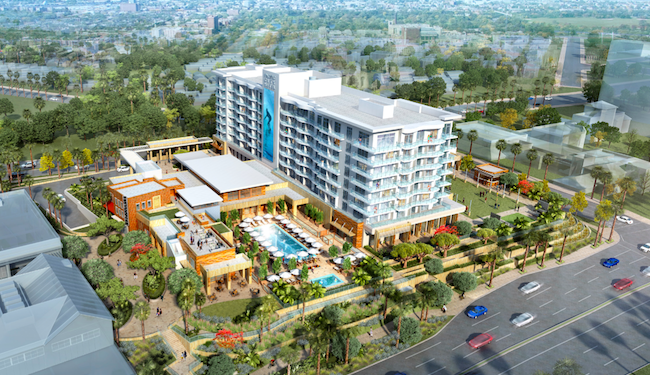RTKL’s parent company Arcadis has announced its intention to acquire Callison, a 1,000+-employee architectural and interior design consultancy with offices in the United States, China, Europe, Middle East and Mexico.
The acquisition of Callison, known predominantly for its leadership in retail and mixed-use design, builds on Arcadis’ strong global design and architecture position, currently provided by RTKL. With the addition of Callison, ARCADIS plans to strengthen its global design leadership in retail and mixed-use, and gain the leading position among international architecture firms in China.
"With the addition of Callison, Arcadis has created a true leadership position in high-end design and architecture,” said Neil McArthur, CEO of ARCADIS. "We will have a clear leading position in retail globally, a strong leadership position in mixed use/commercial globally and will have a leading international design and architecture position in China."
RTKL, which provides architectural and design services across the commercial, healthcare and workplace sectors, was acquired by ARCADIS in 2007. A single global network of RTKL, Arcadis, Callison, and other Arcadis operating companies like EC Harris and Langdon & Seah, further expands the offer for RTKL’s clients through greater scale, a wider range of skills and broader market reach.
Lance Josal, FAIA, President and CEO of RTKL, said: "Callison is a well-respected industry peer, and home to great professionals, including several thought leaders in our industry. Callison has a long history in the profession, a strong culture of client service and share the entrepreneurial drive that took our companies to the global stage. Having two industry leaders within Arcadis provides a great opportunity to create something quite unique."
Arcadis will acquire Callison from its primary owner, Blue Point Capital, and from company management and principals. The closing of the transaction is subject to the satisfaction of customary closing conditions, including the receipt of approval from the Beijing Municipal Commission of Commerce and is expected to be completed in the third quarter of 2014.
"We are excited to be a member of the Arcadis team which has created value for the many other companies that have joined its ranks," said Callison Chairman and CEO John Jastrem. "Our combined global capability will benefit all our employees and clients. We are known for our high quality design and excellent service and with the support of Arcadis we will be able to deliver that quality on an even larger scale."
Related Stories
MFPRO+ New Projects | Oct 30, 2024
BIG’s One High Line finally reaches completion in New York City’s West Chelsea neighborhood
One High Line, a luxury residential project spanning a full city block in New York’s West Chelsea neighborhood, reached completion this summer following years of delays related to investor lawsuits.
Urban Planning | Oct 30, 2024
Bridging the gap: How early architect involvement can revolutionize a city’s capital improvement plans
Capital Improvement Plans (CIPs) typically span three to five years and outline future city projects and their costs. While they set the stage, the design and construction of these projects often extend beyond the CIP window, leading to a disconnect between the initial budget and evolving project scope. This can result in financial shortfalls, forcing cities to cut back on critical project features.
MFPRO+ New Projects | Oct 30, 2024
Luxury waterfront tower in Brooklyn features East River and Manhattan skyline views
Leasing recently began for The Dupont, a 41-story luxury rental property along the Brooklyn, N.Y., waterfront. Located within the 22-acre Greenpoint Landing, where it overlooks the newly constructed Newtown Barge Park, the high-rise features East River and Manhattan skyline views along with 20,000 sf of indoor and outdoor communal space.
Libraries | Oct 30, 2024
Reasons to reinvent the Midcentury academic library
DLR Group's Interior Design Leader Gretchen Holy, Assoc. IIDA, shares the idea that a designer's responsibility to embrace a library’s history, respect its past, and create an environment that will serve student populations for the next 100 years.
Resiliency | Oct 29, 2024
Climate change degrades buildings slowly but steadily
While natural disasters such as hurricanes and wildfires can destroy buildings in minutes, other factors exacerbated by climate change degrade buildings more slowly but still cause costly damage.
Office Buildings | Oct 29, 2024
Editorial call for Office Building project case studies
BD+C editors are looking to feature a roundup of office building projects for 2024, including office-to-residential conversions. Deadline for submission: December 6, 2024.
Healthcare Facilities | Oct 28, 2024
New surgical tower is largest addition to UNC Health campus in Chapel Hill
Construction on UNC Health’s North Carolina Surgical Hospital, the largest addition to the Chapel Hill campus since it was built in 1952, was recently completed. The seven-story, 375,000-sf structure houses 26 operating rooms, four of which are hybrid size to accommodate additional equipment and technology for newly developed procedures.
Multifamily Housing | Oct 28, 2024
A case for mid-rise: How multifamily housing can reshape our cities
Often referred to as “five-over-ones,” the mid-rise apartment type is typically comprised of five stories of apartments on top of a concrete “podium” of ground-floor retail. The main criticism of the “five-over-one” is that they are often too predictable.
Sports and Recreational Facilities | Oct 24, 2024
Stadium renovation plans unveiled for Boston’s National Women’s Soccer League
A city-owned 75-year-old stadium in Boston’s historic Franklin Park will be renovated for a new National Women’s Soccer League team. The park, designed by Fredrick Law Olmsted in the 1880s, is the home of White Stadium, which was built in 1949 and has since fallen into disrepair.
Laboratories | Oct 23, 2024
From sterile to stimulating: The rise of community-centric life sciences campuses
To distinguish their life sciences campuses, developers are partnering with architectural and design firms to reimagine life sciences facilities as vibrant, welcoming destinations. By emphasizing four key elements—wellness, collaboration, biophilic design, and community integration—they are setting their properties apart.

















